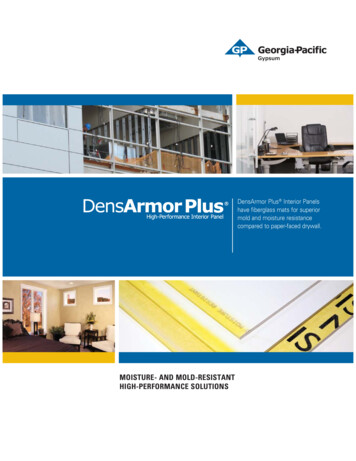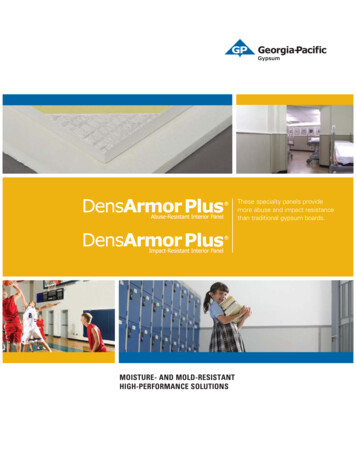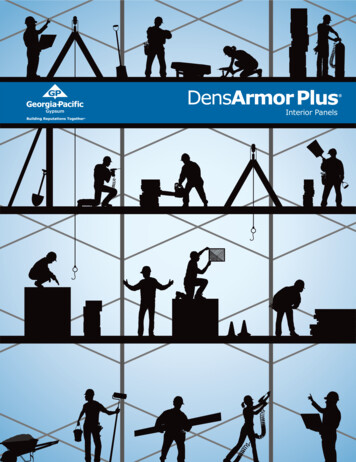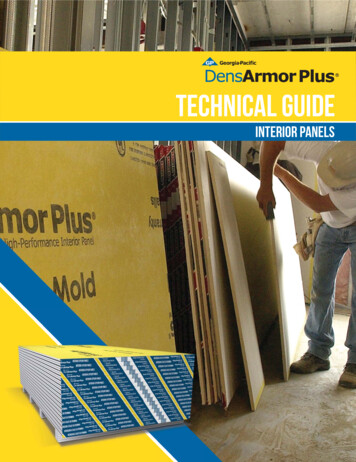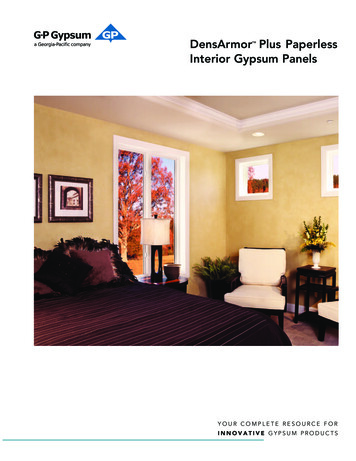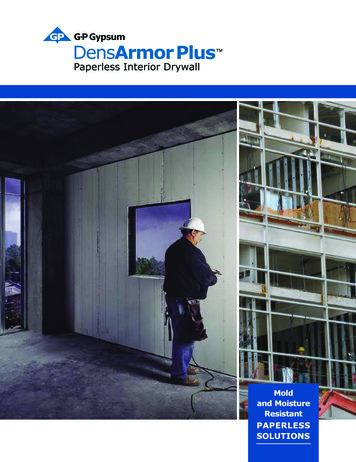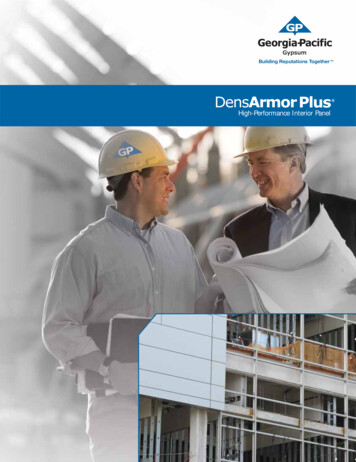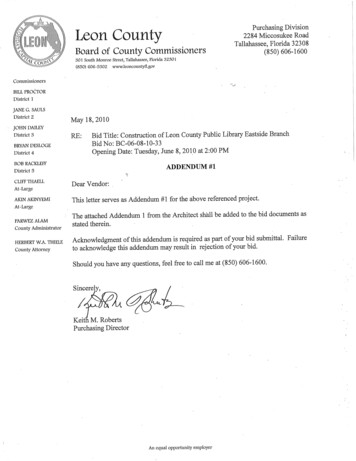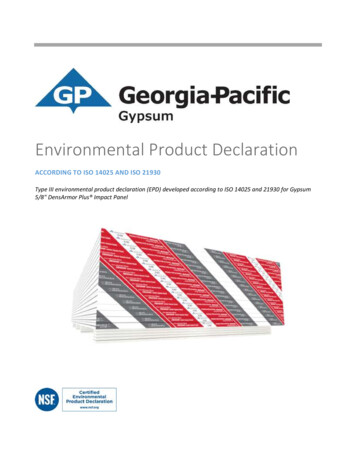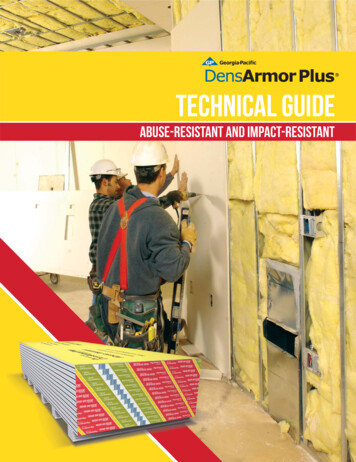
Transcription
TECHNICAL GUIDEabuse-resistant AND IMPACT-RESISTANT
DensArmor Plus Fireguard Abuse-Resistant and Impact-Resistant PanelsProduct OverviewDensArmor Plus Abuse-Resistant Interior PanelEnhancedFiberglass MatsDensArmor Plus Impact-Resistant Interior PanelEmbedded MeshReinforcementEnhancedFiberglass MatsEnhancedMoisture-ResistantGypsum CoreDensArmor Plus Abuse-Resistant Interior Panels 2016 Georgia-Pacific Gypsum LLCTable of ContentsProduct Overview. . . . . . . . . . . . . . . 2Sustainability . . . . . . . . . . . . . . . . . . 3Enhanced ConstructionSchedule. . . . . . . . . . . . . . . . . . . . . . 4Abuse vs. Impact . . . . . . . . . . . . . . . 4Performance Testing —Abuse-ResistanceTesting Methods . . . . . . . . . . . . . . . 6Physical Properties. . . . . . . . . . . . . . 8Installation Instructions . . . . . . . . . . 9Decorative Finishes . . . . . . . . . . . . 10Priming and Painting . . . . . . . . . . . 11Fire- and Sound-RatedAssemblies. . . . . . . . . . . . . . . . . . . 12Delivery, Handling andStorage. . . . . . . . . . . . . . . . . . . . . . 14Recommendationsand Limitations for Use . . . . . . . . . 152 For latest information and updates:EnhancedMoisture-ResistantGypsum CoreDensArmor Plus Impact-Resistant Interior Panels 2016 Georgia-Pacific Gypsum LLCLike DensArmor Plus Interior Panels, DensArmor Plus Abuse-Resistant and Impact-ResistantInterior Panels have fiberglass mats for superior mold- and moisture-resistance compared topaper-faced drywall. Fiberglass mats, instead of paper facings, eliminate a potential food source for mold growthand may reduce remediation and scheduling delays associated with paper-faced drywall Replaces traditional paper-faced abuse- and impact-resistant panels DensArmor Plus Abuse- and Impact-Resistant Panels stand up to ambient moisture andincidental wettings during and after construction Backed with a limited warranty against delamination and deterioration for up to12 months of exposure to normal weather conditions. For complete warranty details,visit www.buildgp.com/warranties.DensArmor Plus Interior Panels are the first gypsum panels to be certified by UL Environment,an independent safety science company, as GREENGUARD and GREENGUARD Gold for lowVOC emissions and are included in UL Environment’s Sustainable Product Guide. DensArmorPlus panels are also listed in the Collaborative for High Performance Schools (CHPS ) HighPerformance Product Database as a low emitting product. CHPS is a national non-profitorganization that works with school districts and their design teams to improve the quality ofeducation by using products that have met requirements to receive CHPS credits.Areas of UseInteriors of exterior walls, where moisture intrusion is most likely.Pre-rock areas, where the windows, doors or roof have not been installed, makingmoisture intrusion inevitable.DensArmor Plus Abuse-Resistant Interior Panels are perfect for hallways, dorm and hospitalrooms and other high traffic areas where scuffing and abrasions may occur.Technical Service Hotline 1.800.225.6119 or www.gpgypsum.comCAUTION: For product fire, safety and use information,go to buildgp.com/safetyinfo.
DensArmor Plus Fireguard Abuse-Resistant and Impact-Resistant PanelsDensArmor Plus Impact-Resistant Interior Panels, with an embedded mesh for the ultimate performance, excel in ultra high trafficareas such as dorms and hospital corridors or secure areas such as correctional institutions.DensArmor Plus Abuse-Resistant and Impact-Resistant Panels feature fiberglass mats on both sides for superior moistureprotection. A revolutionary departure from traditional wallboard, the face of DensArmor Plus panels finishes in a similarmanner to traditional abuse- and impact-resistant gypsum boards and offers superior performance in resisting moisture andmold growth.Integrating DensArmor Plus panels into your specifications is part of an overall building solution that can help address themoisture and mold issue and reduces the time and expense of replacing paper-faced products if they become wet.DensArmor Plus interior panels, which feature fiberglass mats instead of the paper facings used on the surface of traditionalgypsum board products, resist mold growth. When tested, as manufactured, in accordance with ASTM D3273, DensArmor Plusinterior panels have scored a 10, the highest level of performance for mold resistance under the ASTM D3273 test method, atesting method set by ASTM International, which develops testing guidelines and procedures for building materials, products,systems and services. The score of 10, in the ASTM D3273 test, indicates no mold growth in a 4-week controlled laboratorytest. In addition, the mold resistance of DensArmor Plus interior panels have been validated by UL Environment and listed in itsSustainable Product Guide utilizing microbial resistant testing based on ASTM Standard D6329-98. The mold resistance of anybuilding product when used in actual job site conditions may not produce the same results as were achieved in the controlled,laboratory setting. No material can be considered mold proof. When properly used with good design, handling and constructionpractices, DensArmor Plus interior panels provide increased mold resistance compared to standard paper-faced gypsum products.For additional information, go to www.buildgp.com/safetyinfo.Georgia-Pacific Gypsum and SustainabilityGeorgia-Pacific Gypsum’s definition of sustainability is meeting the needs of society today without jeopardizing our ability to do soin the future. We are committed to using resources efficiently to provide innovative products and solutions that meet the needsof customers and society, while operating in a manner that is environmentally and socially responsible, and economically sound.We continue to focus on: Improving energy efficiency at our manufacturing plants Seeking out opportunities to reduce water use, and to reuse water more efficiently Finding cost effective ways to further reduce air emissions Recovering and reusing materials that otherwise would end up in landfills.Green building codes, standards and programs are establishing themselves across the country. They promote the use of productsthat contribute to the performance of the building, along with minimizing environmental and human health impacts over the lifeof the building or home. Because we embrace product performance and operate in an environmentally, socially and economicallysound manner, owners and architects can feel good about the structures they build using our products.Many of our products contribute to LEED and other green building codes, standards or program credits or requirements. To findout more, please refer to www.gpgypsum.com for recycled content, regional materials and low emitting materials informationand use our on-line LEED calculator to calculate contribution for a specific credit. For general information on sustainability, visitwww.buildgp.com/sustainability.CAUTION: For product fire, safety and use information,go to buildgp.com/safetyinfo.For latest information and updates:Technical Service Hotline 1.800.225.6119 or www.gpgypsum.com3
DensArmor Plus Fireguard Abuse-Resistant and Impact-Resistant PanelsEnhanced Construction ScheduleThe unique moisture-resistant features of DensArmor Plus Abuse-Resistant and Impact-Resistant Interior Panels allowbuilders to install gypsum assemblies when it’s not feasible to wait until the building is dried in. Georgia-Pacific GypsumDensArmor Plus Interior Panels offer limited warranties against damage from exposure to normal weather conditions orhumidity if they are stored and installed according to instructions. Paper-faced products are often damaged by wind-drivenrain and moisture during installation. By building from the inside out with these moisture-resistant gypsum products, generalcontractors potentially can complete projects ahead of schedule, and building owners have an opportunity to move payingoccupants in more quickly.Not every project will realize such significant results, and cost savings will vary by project. DensArmor Plus panels offer a12-month limited warranty that guards against delamination and deterioration when exposed to normal weather conditionsduring and after installation, and a three-year limited warranty against manufacturing defects. For complete warranty details,visit www.buildgp.com/warranties.It is very important at the beginning of the specification process to understand the types of abuse a singular structure mustendure in daily operation, and in turn, specify the correct system for that application. A psychiatric hospital, designed to keeppatients in, safe by themselves, and separate from each other may require different type construction than an elementary school,concerned about scuffs and dents. Both structures require durable gypsum products, but the most appropriate material should bespecified. By understanding the short term requirements, long term money can be saved.Abuse-Resistant vs. Impact-Resistant Interior Panels“High traffic” is a relative term when it comes to any building project. Any commercial, institutional or residential buildingcan include such a space. Regardless of the application, however, there are two types of potential damage that architects mustconsider when specifying a wall system for a high-traffic area:Abuse Resistance: Abrasion or scuffing of the walls due to high traffic of daily operations and indentation of the wallsurface; the occasional contact by humans, cleaning equipment and the gentle shoves of furniture. Generally used in hightraffic areas, abuse-resistant gypsum board reduces lifecycle cost by significantly increasing the time period betweenperiodic maintenance and improvement of the walls’ appearance. Abuse resistance is an important design considerationfor interior areas where a higher resistance to abrasion, indentation and impact penetration is required.Impact Resistance: Damage due to continuous impact or high energy that can tear into the stud cavity. Usingappropriate materials to resist damage not only contributes to long-term looks and appeal, but also decreases short termmaintenance costs of repairing the dents in the wall surface, and/or the possibility of intrusion into the inside of the wall.Georgia-Pacific DensArmor Plus Abuse-Resistant and Impact-Resistant panels provide architects with appropriate and costeffective gypsum panel solutions that resist wall damage, while keeping design flexibility high. These materials, along withproper systems, have helped bridge the gap between design and strength.The markets for Georgia-Pacific DensArmor Plus Abuse-Resistant and Impact-Resistant panels have grown over time. They areoften placed together in one gypsum category by architects and those who specify material for a job. They are thought to beinterchangeable. The truth is they are separate product lines with different applications. Because of the activities taking placeinside a facility, one must specify gypsum panels for specific applications.While abuse-resistant panels are now commonly used in hospitals, sometimes architects specify impact resistance for applicationswhere a less expensive abuse-resistant board will do the job. If there is a concern about incidental damage, such as things orpeople accidentally banging into the walls, then DensArmor Plus Fireguard Abuse-Resistant panels are fine. The appropriateword is accident.If people are purposely trying to destroy walls, such as prison inmates or patients in psychiatric wards, then DensArmor PlusFireguard Impact-Resistant panels would be the best solution. The appropriate words are intentional impact.4 For latest information and updates:Technical Service Hotline 1.800.225.6119 or www.gpgypsum.comCAUTION: For product fire, safety and use information,go to buildgp.com/safetyinfo.
DensArmor Plus Fireguard Abuse-Resistant and Impact-Resistant PanelsIndustry StandardsAnother way to understand the difference between penetration and surface damage is graphically. At the most basic level,abuse resistance can be defined as the ability of a partition system to resist two primary types of wall damage.Surface Damage: Abrasion and IndentationThis includes surface damage that can be caused by regular, ordinary contactwith people and furniture, as well as contact with various moving objects such asa medical gurney, mail carts, vacuum cleaners and other cleaning equipment.Penetration: Both Hard-Body and Soft-BodyHard-Body: hard objects, machinery, toolsSoft-Body: human or animalThe impact of penetration through the partition into the wall cavity, causingdamage that can be expensive to repair and in some instances dangerous.Applications and LevelsThere are three separate levels of abuse resistance to help building owners and/or design professionals determine the type andamount of durability needed for specific building applications. Each category is described below. Each category shown representsan improvement over standard interior drywall construction.LightDutyMild to ModerateDutyExtremeDutyFor areas requiring a basicupgrade to standard drywall,with improved resistanceto incidental surface andindentation damage.Incidental DamageSingle-family homesCafeterias/public areas in medical institutionsElementary school classrooms/stairwellsFor areas requiring a moderateresistance to incidental surfacedamage, indentation andpenetration, damage frompeople and objects.Middle/high school – classrooms, stairwellsCollege lecture hallsMulti-family stairways – common areasMailroomsShipping/receiving areasShopping centersUnintended DamageFor areas requiring resistanceto extreme levels of penetrationand/or surface indentation, anddamage from hard objects.Court detention facilitiesGovernment/military installationsAirportsSports facilitiesHospital corridorsGymnasiumsExtreme DamageTesting Methods—Significance and UseAbuse-resistant systems are tested to ensure long-term performance in real world applications. Georgia-Pacific DensArmor Plus Abuse-Resistant and Impact Resistant panels undergo testing to ensure that they meet exacting standards. Independent productsand systems are tested in accordance with ASTM standards. ASTM International established abuse- and impact-resistancestandards to measure the ability of gypsum panels to withstand surface abrasion, indentation and wall penetration.The standard ASTM C1629, “Standard Classification for Abuse-Resistant, Non-Decorated Interior Gypsum Panel Products andFiber-Reinforced Cement Panels,” is the result of an industry initiative for testing method unification.Each abuse impact property of abuse-resistant wall panels is divided into three classification levels. The three levels ofclassification are: Level I, Level II and Level III.The test methods specified are utilized to establish the abuse-resistance classification of an abuse-resistant wall panel. Eachclassification level requires a minimum overall specified performance. Any classified abuse-resistant wall panel can be used at aclassification level which is rated lower than the highest level qualified.It is critical to understand the ASTM testing methods, as well as the optimal usage for various enhanced gypsum wallboards;this is integral to maximizing durability, design flexibility and long-term cost efficiency of high traffic and high use areas.CAUTION: For product fire, safety and use information,go to buildgp.com/safetyinfo.For latest information and updates:Technical Service Hotline 1.800.225.6119 or www.gpgypsum.com5
DensArmor Plus Fireguard Abuse-Resistant and Impact-Resistant PanelsPerformance Testing – Abuse-Resistance Testing MethodsTo see in-house abuse and impact performance tests in action, visit www.youtube.com/gpdens.Surface Damage, Abrasion Resistance Modified—ASTM D4977This test method measures the ability of a gypsum panel surface to resist scratches andscuff marks by subjecting the panel to 50 back and forth cycles with a brush. This testwas intended for mineral-surfaced roofing products and was modified with additionalweight for a total of 25 lbs. (11 Kg) to provide a suitable test of the abrasion resistanceof wall panel products. In this test, the sample material is placed under a movingweighted wire brush. The value reported for the test reflects the number of cycles towhich the partition can be exposed prior to failure. Failure is recorded as the depth ofabrasion after 50 cycles.Surface Abrasion(Modified ASTM D4977)Interpreting Results: The board with the least amount of “rub” is the mostabrasion resistant.Surface Damage, Indentation Resistance—ASTM D5420This test method, sometimes referred to in the industry as the “Gardner Impact Test 1,”was originally used to measure the impact resistance or toughness of plastic material.This test was modified to test gypsum panels in the same manner. This test measuresthe ability of a gypsum panel to resist dents from small hard objects. In this test, an 8 lb.(4 Kg) weight is raised 9” (229 mm) above the material, then dropped onto a small 5/8”(15.9 mm) round die which hits the sample gypsum panel. The depth of the indentationis measured and recorded. The results are the average of three or more tests.Surface Indentation (ASTM D5420–Gardner Impact Test)Interpreting Results: The less penetration, the better.Penetration Soft-Body Impact Modified—ASTM E695This test method covers the measurement of the relative resistance of wall, floor androof construction to impact loading. Sources of impact may include accidental impactfrom a human body due to pushing, shoving or falling; or moving heavy objects suchas furniture. Soft-body impact resistance testing uses a 60 lb. (27 Kg) leather bagwhich is pulled away from the sample in 6” (150 mm) increments and released. Thevalues reported represent the foot-pounds (joules) of energy required to produce failureof the partition.Single Drop Soft-Body Impact(Modified ASTM E695)Interpreting Results: The higher the level recorded, the better the soft-bodyimpact performance.Penetration Hard-Body Impact ASTM C1629—Annex A1This proposed test method is as follows: samples of drywall, 24” x 24” (610 x 610 mm),are mounted on 3-5/8” (92 mm) 20-gauge* (30 mils) steel studs, 16” (406 mm) o.c.Hard-Body Impact(ASTM C1629 A1)A 2-3/4” (70 mm) diameter steel ram is driven into the board surface. The weight isincreased until failure. A new panel is used for each impact. By increasing the weightof the ram, this increases the amount of impact energy which will impede the partitionassembly. This is measured in foot-pounds. Hard-body impact resistance testing uses aweighted ram which is pulled away from the sample and released. The value reportedis the maximum amount of impact force required to cause penetration into the partitioncavity with a single blow (defined as failure of the system).Interpreting Results: The higher the level, the greater the resistance tohard-body impact.*For effective and equivalent gauge steel studs, we have no evaluation or installation recommendations.6 For latest information and updates:Technical Service Hotline 1.800.225.6119 or www.gpgypsum.comCAUTION: For product fire, safety and use information,go to buildgp.com/safetyinfo.
DensArmor Plus Fireguard Abuse-Resistant and Impact-Resistant PanelsDensArmor Plus Abuse-Resistant Interior Panels Test Results—Single Layer—ASTM C1629TestSurface AbrasionSurface DamageASTM D4977Surface IndentationSurface DamageASTM D5420Soft-Body ImpactPenetrationASTM E695General Description of TestA wire brush is cycled across the boardsurface. Failure is recorded as the depthof abrasion after 50 cycles. The lower thenumber the better the abrasion resistance.An 8 lb. (3.6 Kg) weight is raised 9”(229 mm), then dropped onto a small 5/8”(16 mm) round die which hits the sample.The value reported is the average of 3 ormore tests.A leather bag filled with 60 lbs. (27 Kg) ofshot is released against the surface of theboard at increasing height until failure.Test Result Criteria1. 0.126” (3.2 mm)2. 0.059” (1.5 mm)3. 0.010” (.3 mm)Product Test ResultLevel 3Indentation Resistance1. 0.150” (3.8 mm)2. 0.100” (2.5 mm)3. 0.050” (1.3 mm)Level 1Soft Body1. 90 ft lbs (122 J)2. 195 ft lbs (265 J)3. 300 ft lbs (405 J)Level 1DensArmor Plus Impact-Resistant Interior Panels Test Results—Single Layer—ASTM C1629TestSurface AbrasionSurface DamageASTM D4977Soft-Body ImpactPenetrationASTM E695General Description of TestA wire brush is cycled across the boardsurface. Failure is recorded as the depthof abrasion after 50 cycles. The lower thenumber the better the abrasion resistance.An 8 lb. (3.6 Kg) weight is raised 9”(229 mm), then dropped onto a small 5/8”(15.9 mm) round die which hits the sample.The value reported is the average of 3 ormore tests.A leather bag filled with 60 lbs. (27 Kg) ofshot is released against the surface of theboard at increasing height until failure.Hard-Body ImpactPenetrationASTM C1629A 2-3/4” (70 mm) diameter steel ram isdriven into the board surface. Weight isincreased until failure.Surface IndentationSurface DamageASTM D5420Test Result Criteria1. 0.126” (3.2 mm)2. 0.059” (1.5 mm)3. 0.010” (.3 mm)Product Test ResultLevel 3Indentation Resistance1. 0.150” (3.8 mm)2. 0.100” (2.5 mm)3. 0.050” (1.3 mm)Level 1Soft Body1. 90 ft lbs (122 J)2. 195 ft lbs (265 J)3. 300 ft lbs (405 J)Hard Body1. 50 ft lbs (68 J)2. 100 ft lbs (136 J)3. 150 ft lbs (204 J)Level 3Level 2DensArmor Plus Fireguard Impact-Resistant Interior Panels Test Results—Double Layer—ASTM C1629Base Layer: 5/8” (15.9 mm) DensArmor Plus Fireguard panel or 5/8” (15.9 mm) DensArmor Plus Impact-Resistant panel;Face Layer: 5/8” (15.9 mm) DensArmor Plus Fireguard Impact-Resistant panelTestSurface AbrasionSurface DamageASTM D4977Soft-Body ImpactPenetrationASTM E695General Description of TestA wire brush is cycled across the boardsurface. Failure is recorded as the depthof abrasion after 50 cycles. The lower thenumber the better the abrasion resistance.An 8 lb. (3.6 Kg) weight is raised 9”(229 mm), then dropped onto a small 5/8”(15.9 mm) round die which hits the sample.The value reported is the average of 3 ormore tests.A leather bag filled with 60 lbs. (27 Kg) ofshot is released against the surface of theboard at increasing height until failure.Hard-Body ImpactPenetrationASTM C1629A 2-3/4” (70 mm) diameter steel ram isdriven into the board surface. Weight isincreased until failure.Surface IndentationSurface DamageASTM D5420CAUTION: For product fire, safety and use information,go to buildgp.com/safetyinfo.Test Result Criteria1. 0.126” (3.2 mm)2. 0.059” (1.5 mm)3. 0.010” (.3 mm)Product Test ResultLevel 3Indentation Resistance1. 0.150” (3.8 mm)2. 0.100” (2.5 mm)3. 0.050” (1.3 mm)Level 2Soft Body1. 90 ft lbs (122 J)2. 195 ft lbs (265 J)3. 300 ft lbs (405 J)Hard Body1. 50 ft lbs (68 J)2. 100 ft lbs (136 J)3. 150 ft lbs (204 J)Level 3Level 3For latest information and updates:Technical Service Hotline 1.800.225.6119 or www.gpgypsum.com7
DensArmor Plus Fireguard Abuse-Resistant and Impact-Resistant PanelsPhysical PropertiesPropertiesDensArmor Plus Fireguard Abuse-Resistant PanelDensArmor Plus Fireguard Impact-Resistant PanelThickness, nominal5/8” (15.9 mm) 1/64” (0.4 mm)4’ (1219 mm) 3/32” (2.4 mm)8’ (2438 mm) to10’ (3048 mm) 1/4” (6.4 mm)2.8 (13.7) 10 (570) 100 (444) 140 (622).67 (0.118) 90 (400) 15 (67) 5 1.6 grams5/8” (15.9 mm) 1/64” (0.4 mm)4’ (1219 mm) 3/32” (2.4 mm)8’ (2438 mm) to10’ (3048 mm) 1/4” (6.4 mm)3.0 (14.6) 10 (570) 100 (444) 140 (622).67 (0.118) 90 (400) 15 (67) 5 1.6 grams0/0 1/8” (3 mm)Noncombustible6.25 x 10-60/0 1/8” (3 mm)Noncombustible6.25 x 10-68.5 x 10-6 (15.3 x 10-6)8.5 x 10-6 (15.3 x 10-6)Width, standardLength, standardWeight1 nominal, lbs./sq. ft. (Kg/m2)Permeance,6 Perms (ng/Pa s m2)Flexural strength, parallel, lbf.3, 4 (N)Flexural strength, perpendicular, lbf.3, 4 (N)R Value2 ft² F hr/BTU (m² K/W)Nail pull resistance minimum, lbf.3, 4 (N)Hardness core, edges and ends, lbf.3, 4 (N)Water absorption (% of weight) 3, 4Surface water absorption3, 4Surface burning characteristics (per ASTM E84 orCAN/ULC-S102): flame spread/smoke developedHumidified deflection, inches 3, 4Combustibility 5Linear expansion with moisture change in/in %RH(mm/mm/%RH)7Coefficient of thermal expansion in/in/ F (mm/mm/ C)8Represents approximate weight for design and shipping purposes. Actual weight may varybased on manufacturing location and other factors.2Tested in accordance with ASTM C518.3Tested in accordance with ASTM C473.4Specified values per ASTM C1658.5As defined and tested in accordance with ASTM E136 or CAN/ULC S114.6Tested in accordance with ASTM E96 (dry cup method).7As stated by Gypsum Association GA-235.8Tested in accordance with ASTM E228-95.18 For latest information and updates:Technical Service Hotline 1.800.225.6119 or www.gpgypsum.comCAUTION: For product fire, safety and use information,go to buildgp.com/safetyinfo.
DensArmor Plus Fireguard Abuse-Resistant and Impact-Resistant PanelsInstallation InstructionsDensArmor Plus Abuse-Resistant and Impact-Resistant Interior Panels are installed in a similar manner to traditional paperfaced drywall. DensArmor Plus panels should be installed according to the most current versions of Gypsum AssociationPublication GA-216 “Application and Finishing of Gypsum Panel Products” and ASTM C840 “Standard Specification forApplication and Finishing of Gypsum Board for Non-Fire Rated Construction.” Where applicable, abut DensArmor Plus panelsagainst regular paper-faced drywall only at inside or outside corners to eliminate transitions in the field of a wall or ceiling.Adjust fastening tools to ensure that the fasteners are not over-driven through the face of the panel. Nails and screws shouldbe driven with the heads slightly below the surface of the panel.1. DensArmor Plus Abuse- and Impact-Resistant panels shall be installed on a minimum of 20-gauge (30 mils) steel studs,16” (406 mm) o.c.2. For fire-rated installations, the installation and details shall be in conformity with the appropriate assemblies, if any,incorporating these products published in the Gypsum Association Fire Resistance Design Manual GA-600, and UL andULC Fire Resistance Directories.3. For best results, screw locations shall be countersunk before screw application.4. The diameter of the screw head will determine the size of the countersink bit. Countersink should not exceed the diameterof the screw head.5. Screws shall be spaced not more than 12” (305 mm) on center along the framing members for ceilings and 16” (406mm) on center for walls where the framing members are 16” (406 mm) on center. Screws shall be spaced not more than12” (305 mm) on center along the framing members for ceilings and walls where framing members are 24” (610 mm) oncenter. When fire-rated assemblies are required, follow the more stringent fastening requirement.6. When using a combination of fasteners consisting of nails along the perimeter and screws in the field of the gypsumboard, the spacing between a nail and an adjacent screw shall not be more than the spacing specified for screws.7. Screws shall be driven to provide screw head penetration just below the DensArmor Plus panel surface without breakingthe fiberglass mat surface of the panel or stripping the framing member around the screw shank.8. Suitable fascia and molding shall be provided around the perimeter to protect the DensArmor Plus panels from directexposure to water. Unless protected by metal or other water stops, the edges of the DensArmor Plus boards shall beplaced not less than 1/2” (13 mm) away from the abutting vertical surfaces. Do not allow water to pond on DensArmorPlus panels.9. DensArmor Plus Abuse- and Impact-Resistant panels are engineered to have higher density gypsum cores. In addition toenhancing the necessary physical properties to meet ASTM C1629 requirements, the core also enhances the product’snail pull resistance. As with all gypsum products, it’s important to not over drive the fastener. Breaking the mat when thescrew is applied does not affect the physical performance of the fire resistance of the panel.CAUTION: For product fire, safety and use information,go to buildgp.com/safetyinfo.For latest information and updates:Technical Service Hotline 1.800.225.6119 or www.gpgypsum.com9
DensArmor Plus Fireguard Abuse-Resistant and Impact-Resistant PanelsDecorative FinishesJoint FinishingThe finishing and sanding of DensArmor Plus Interior Panels should be performed in accordance with the most current version ofGypsum Association Publication GA-214 “Recommended Levels of Gypsum Board Finish.” Joints between DensArmor Plus panelsmay be finished with either paper tape embedded with all-purpose joint compound or with fiberglass mesh tape and settingcompound. Because of the enhanced moisture- and mold-resistant properties of DensArmor Plus panels, drying times for thejoint and setting compounds may vary slightly. It is essential to allow each coat of compound to dry thoroughly before applyingadditional coats of compound. Care should be taken to ensure that all joints and fasteners are properly and adequately sanded toprovide a smooth transition between the compound and the face of the panel.Critical (Severe) Lighting Areas and Gloss PaintsWhen using gloss or semi-gloss paint, or when working in a critical (severe) lighting area, always finish DensArmor Pluspanels to a Level 5 finish as detailed in GA-214. Critical lighting areas include but are not limited to walls and ceiling areasnear windows and skylights, long hallways and atriums with large surface areas exposed to artificial and/or natural light.Refer to GA-214 for additional examples.Adhered WallcoveringsBecause of the enhanced moisture- and mold-resistant properties of DensArmor Plus panels, drying times for the wallcoveringadhesives and primers may vary slightly. Some wallcoverings, such as an unbacked vinyl wallcovering, require a Level 5
DensArmor Plus Impact-Resistant Interior Panels, with an embedded mesh for the ultimate performance, excel in ultra high traffic areas such as dorms and hospital corridors or secure areas such as correctional institutions. DensArmor Plus Abuse-Resistant and Impact-Resistant Panels fe
